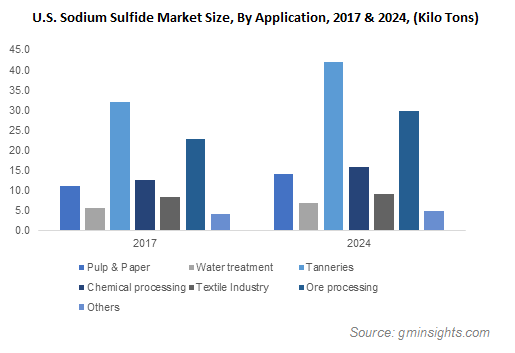Home > Chemicals & Materials > Specialty Chemicals > Custom Synthesis > Sodium Sulfide Market
Sodium Sulfide Market Analysis
- Report ID: GMI3006
- Published Date: Nov 2018
- Report Format: PDF
Sodium Sulfide Market Analysis
Low ferric sodium sulfide segment surpassed $180 million in 2017. This product finds wide use in high-grade paper, medicine, leather, PPS plastic, dyeing and printing industries. Moreover, it offers various advantages such as high solubility in alcohol and water, which imparts a tendency to absorb atmospheric moisture and form a solution further stimulating the sodium sulfide market.
Anhydrous Na2S should witness gains of over 6.5% through 2024 owing to its wide use in gold ore hydrometallurgy, rayon dyeing, paper, leather and organic chemical manufacturing industries. Moreover, growing personal care applications for toenail trimming, in which the product performs a softening role for pain reduction may further stimulate the sodium sulfide market share.
Technical grade sodium sulfide market segment surpassed $290 million in 2017 owing to the product’s vital role in dye, oil recovery, ore flotation, and detergent manufacture. Moreover, this product acts as an oxygen scavenging agent in water treatment, dechlorinating agent in tanneries, and as a textile bleaching agent & sulfonation agent in chemical manufacturing.
Purified grade segment may witness gains of over 6.5% in the forecast timeframe. This product is primarily used in the Kraft process in the paper and pulp industries but its high solubility in water compared to oxides and fluorides may increase sodium sulfide market demand from the water treatment industry.
Sodium sulfide market size from pulp & paper applications was valued over USD 45 million in 2017. Increasing demand for hygiene products, tissue papers and packaging may increase the requirement for paper pulp. For instance, Japan’s packaging market size exceeded USD 45 billion in 2017 which indicates ample growth opportunities. The pulp & paper industry converts wood into paper, cardboard & similar products with the aid of sodium sulphide, which may stimulate product demand.
Tanneries applications may witness gains of over 5% in the predicted timeframe. This product is used in the processing of different leather varieties which improves the softness and quality of the manufactured item. It also ensures the removal of other undesirable material such as non-collagenous proteins, epidermis and cementing substances from the skin which may further boost the sodium sulfide market.
Processing applications may exceed $150 million by 2024. This product ensures that the ore surface is free from products of hydrophilic oxidation which is vital for successful ore flotation. It finds usage in the processing of various types of ores such as chalcopyrite, molybdenite, silver, and chromite which may enhance sodium sulphide market.
North America led by the U.S., Canada and Mexico was valued at $110 million in 2017. The region is witnessing rising demand for ferrous metals such as iron & steel along with non-ferrous metals such as zinc, copper & lead which has stimulated ore processing business growth. The product protects the ore surface from hydrophilic oxidation, thereby promoting ore flotation which may further accentuate the sodium sulfide market value.
Europe led by Germany, UK and France should witness gains of over 5% by 2024. This region has a strong leather processing industry which produces & exports various types of leather from livestock including calves, bovine, goat and sheep which caters to the garment, footwear and furniture businesses. This product enables the softening of tough leather and plays a vital role in processing animal skin which may boost the sodium sulfide market.
Asia Pacific led by China, India, and South Korea should reach $305 million by 2024. These countries face an increasing demand for designer leather bags, footwear, and accessories pertaining to rising disposable incomes, significant economic growth, and population rise. This product breaks down cystine bonds in the keratin of animal hair cortexes, ensuring effective hair removal during leather production and increasing the sodium sulfide industry demand.

